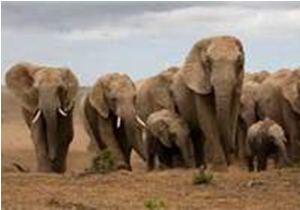News
Latest Lion Aid News
Flawed economic models will not conserve elephants
Tuesday 29th January 2013
|
Treat them like cattle In a recent article in Forbes Magazine , contributor Doug Bandow sought to apply economic theories to the current elephant poaching crisis. Allow legal sales of ivory Mr Bandow claimed, and the poaching will disappear. I have problems with this concept (previously stated many times) and here will show you why economic models cannot be applied to the ivory trade, legal or illegal. Mr Bandow makes the following points:
Mr Bandow also makes several economic mistakes. First, he assumes that the level of demand for ivory is known. This is a big error, as many have stated that China can this minute absorb all the ivory from every living elephant and more. And China is not the only Asian country interested in ivory – it is joined by Thailand, the Philippines, Vietnam, Taiwan, South Korea to name but a few. And there is a great interest in ivory from Europe, Russia and the USA. If the level of demand is not known, how can Mr Bandow assume that any level of supply can satisfy that demand? Second, Mr Bandow assumes to know something about elephants. This is a long-lived species with high intelligence and close family bonds. It is therefore difficult to “harvest” without unforeseen consequences to herd structure and future reproduction. Mr Bandow says that elephants need to be “treated like cattle”, and thereby exposes his complete ignorance. Harvesting a few elephants here and there to provide the demand for ivory is not at all like harvesting a few cows from a farmer’s herd. Third, Mr Bandow does not understand the complexities of the ivory trade. He could have consulted the good article in the National Geographic Magazine written by Bryan Christy that clearly stated how the 2008 CITES approved ivory sale was manipulated by China – instead of lowering the price of ivory due to the windfall, the Chinese authorities both raised the price of ivory and limited sales to the Chinese buyers. This flies in the face of economic predictions – the Chinese demand a lot of ivory but will not lower the price once it is available. Therefore, illegal ivory is much cheaper, and the release of legal ivory into the Chinese market can be used forever to justify ivory sales as nobody is actually monitoring the volume of legal ivory sold in China (and elsewhere) versus the volume (legal and illegal) received. Fourth, Mr Bandow quotes some completely irrelevant examples to support his thesis that “markets have been the key to conservation”. For example, he mentions that vicunas (a South American relative of the llama coveted for their fine wool) have recovered from near extinction due to captive breeding and non-lethal harvests from wild populations. And that crocodile numbers have recovered as well due to captive breeding – and then he goes onto very thin ice by mentioning that China is now “farming” tigers to supply body parts. Mr Bandow is now clearly showing both his economic and biological ignorance. The captive breeding of tigers to supply a market has not satisfied the demand by any means – wild tigers are still being poached, and now lion parts are being substituted to make up the tiger shortfall. Farming crocodiles and snakes for their skins (handbags, shoes, wallets) has not decreased poaching at all – it is much easier to kill a species in the wild than spend the many years waiting for it to grow up on a “farm”. I hate to be the one to break this to Mr Bandow, but one cannot farm elephants. Fifth, Mr Bandow fails completely to factor into his economic equation the value of a live elephant versus a dead one. The latter is easy – you take the weight of the tusks, the meat value, and if you have a proper abattoir like the ones that used to exist in the Kruger National Park in South Africa, you can include the value of bone meal and canned meat. But what is the value of a live elephant? I’m not an economist (thanks be) but I can perfectly well make an estimate – after all, economics is not a precise science as small clues like the collapse of the world economy indicate. So let me do this simple evaluation. Kenya earns, conservatively, $500 million per year from overseas visitors who come to view wildlife. These people like to see elephants. Kenya has about 25,000 elephants, so each elephant is worth about $20,000 per year to Kenya. Elephants conservatively live about 40 years. So one elephant is worth about $800,000 during its lifetime to tourism in Kenya. A dead elephant is only valued in Kenya for the ivory – the carcass is left in the bush to rot away. Let’s say the dead elephant carried a generous 20 kg of ivory and ignore the fact that very small elephants are also killed by poachers. It appears that ivory on the street in China now has a value of $2200/kg. So a dead elephant is worth $44,000 in terms of ivory delivered to China and perhaps $100 to the poacher in Kenya. Do you see the difference Mr Bandow? Sixth, Mr Bandow is completely accurate when he says three things:
And let’s ensure that commerce never dictates the value of an elephant. Picture credit: Addoselfcatering.co.za Please support us if you can to conserve the remaining fragile lion populations. Thank you. Tags: CITES, elephants, China, poaching, ivory, Forbes Magazine, Categories: Economics of Wildlife |
Posted by Pieter Kat at 13:19
No comments have been posted yet.
Add a new comment
Existing user
New user sign up




